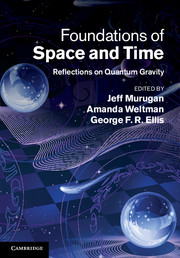Book contents
- Frontmatter
- Contents
- List of contributors
- 1 The problem with quantum gravity
- 2 A dialogue on the nature of gravity
- 3 Effective theories and modifications of gravity
- 4 The small-scale structure of spacetime
- 5 Ultraviolet divergences in supersymmetric theories
- 6 Cosmological quantum billiards
- 7 Progress in RNS string theory and pure spinors
- 8 Recent trends in superstring phenomenology
- 9 Emergent spacetime
- 10 Loop quantum gravity
- 11 Loop quantum gravity and cosmology
- 12 The microscopic dynamics of quantum space as a group field theory
- 13 Causal dynamical triangulations and the quest for quantum gravity
- 14 Proper time is stochastic time in 2D quantum gravity
- 15 Logic is to the quantum as geometry is to gravity
- 16 Causal sets: discreteness without symmetry breaking
- 17 The Big Bang, quantum gravity and black-hole information loss
- 18 Conversations in string theory
- Index
- References
7 - Progress in RNS string theory and pure spinors
Published online by Cambridge University Press: 05 August 2012
- Frontmatter
- Contents
- List of contributors
- 1 The problem with quantum gravity
- 2 A dialogue on the nature of gravity
- 3 Effective theories and modifications of gravity
- 4 The small-scale structure of spacetime
- 5 Ultraviolet divergences in supersymmetric theories
- 6 Cosmological quantum billiards
- 7 Progress in RNS string theory and pure spinors
- 8 Recent trends in superstring phenomenology
- 9 Emergent spacetime
- 10 Loop quantum gravity
- 11 Loop quantum gravity and cosmology
- 12 The microscopic dynamics of quantum space as a group field theory
- 13 Causal dynamical triangulations and the quest for quantum gravity
- 14 Proper time is stochastic time in 2D quantum gravity
- 15 Logic is to the quantum as geometry is to gravity
- 16 Causal sets: discreteness without symmetry breaking
- 17 The Big Bang, quantum gravity and black-hole information loss
- 18 Conversations in string theory
- Index
- References
Summary
This chapter is a review of the program of understanding the gauge theory/gravity correspondence through a study of the RNS superstring. In particular, we show how to define string field theory actions in curved backgrounds by constructing a sequence of new nilpotent BRST operators in RNS string theory. Our construction is based on the presence of local gauge symmetries in RNS superstring theory leading to an infinite chain of new BRST generators that can be classified in terms of ghost cohomologies.
Introduction
Gauge–string duality is arguably one of the most profound problems in modern physics [1–11]. This duality implies that the gauge-invariant observables (operators) in QCD are in one-to-one correspondence with the physical states (vertex operators) in string theory. The reason why extended objects (such as strings) appear in QCD is quite natural. If we recall standard electrodynamics, there are two ways of describing it: either in terms of local electric fields (Coulomb's approach), or in terms of the geometry of electric field lines (Faraday's approach). In the case of electromagnetic theory, Coulomb's approach turns out to be far more efficient. In the case of QCD, however, things are quite different. While the electric field lines created by the charged particles are spread over the entire space, the gluon field lines are confined to thin flux tubes. These flux tubes, connecting quarks, can be naturally interpreted as one-dimensional extended objects, known as QCD strings.
- Type
- Chapter
- Information
- Foundations of Space and TimeReflections on Quantum Gravity, pp. 125 - 139Publisher: Cambridge University PressPrint publication year: 2012



